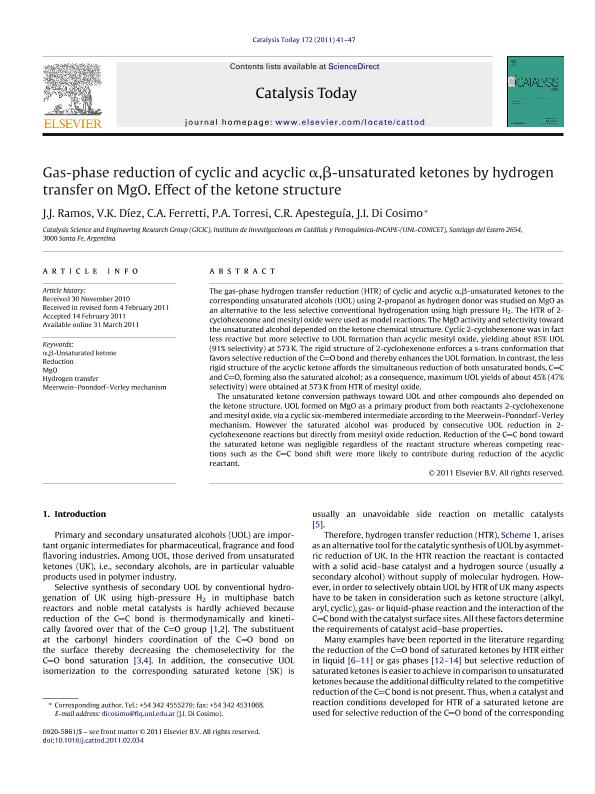Artículo
Gas-phase reduction of cyclic and acyclic α,β-unsaturated ketones by hydrogen transfer on MgO. Effect of the ketone structure
Ramos, J. J.; Diez, Veronica Karina ; Ferretti, Cristián Alejandro
; Ferretti, Cristián Alejandro ; Torresi, Pablo Antonio
; Torresi, Pablo Antonio ; Apesteguia, Carlos Rodolfo
; Apesteguia, Carlos Rodolfo ; Di Cosimo, Juana Isabel
; Di Cosimo, Juana Isabel
 ; Ferretti, Cristián Alejandro
; Ferretti, Cristián Alejandro ; Torresi, Pablo Antonio
; Torresi, Pablo Antonio ; Apesteguia, Carlos Rodolfo
; Apesteguia, Carlos Rodolfo ; Di Cosimo, Juana Isabel
; Di Cosimo, Juana Isabel
Fecha de publicación:
08/2011
Editorial:
Elsevier Science
Revista:
Catalysis Today
ISSN:
0920-5861
Idioma:
Inglés
Tipo de recurso:
Artículo publicado
Clasificación temática:
Resumen
The gas-phase hydrogen transfer reduction (HTR) of cyclic and acyclic α,β-unsaturated ketones to the corresponding unsaturated alcohols (UOL) using 2-propanol as hydrogen donor was studied on MgO as an alternative to the less selective conventional hydrogenation using high pressure H 2. The HTR of 2-cyclohexenone and mesityl oxide were used as model reactions. The MgO activity and selectivity toward the unsaturated alcohol depended on the ketone chemical structure. Cyclic 2-cyclohexenone was in fact less reactive but more selective to UOL formation than acyclic mesityl oxide, yielding about 85% UOL (91% selectivity) at 573 K. The rigid structure of 2-cyclohexenone enforces a s-trans conformation that favors selective reduction of the CO bond and thereby enhances the UOL formation. In contrast, the less rigid structure of the acyclic ketone affords the simultaneous reduction of both unsaturated bonds, CC and CO, forming also the saturated alcohol; as a consequence, maximum UOL yields of about 45% (47% selectivity) were obtained at 573 K from HTR of mesityl oxide. The unsaturated ketone conversion pathways toward UOL and other compounds also depended on the ketone structure. UOL formed on MgO as a primary product from both reactants 2-cyclohexenone and mesityl oxide, via a cyclic six-membered intermediate according to the Meerwein-Ponndorf-Verley mechanism. However the saturated alcohol was produced by consecutive UOL reduction in 2-cyclohexenone reactions but directly from mesityl oxide reduction. Reduction of the CC bond toward the saturated ketone was negligible regardless of the reactant structure whereas competing reactions such as the CC bond shift were more likely to contribute during reduction of the acyclic reactant.
Archivos asociados
Licencia
Identificadores
Colecciones
Articulos(INCAPE)
Articulos de INST.DE INVEST.EN CATALISIS Y PETROQUIMICA "ING. JOSE MIGUEL PARERA"
Articulos de INST.DE INVEST.EN CATALISIS Y PETROQUIMICA "ING. JOSE MIGUEL PARERA"
Citación
Ramos, J. J.; Diez, Veronica Karina; Ferretti, Cristián Alejandro; Torresi, Pablo Antonio; Apesteguia, Carlos Rodolfo; et al.; Gas-phase reduction of cyclic and acyclic α,β-unsaturated ketones by hydrogen transfer on MgO. Effect of the ketone structure; Elsevier Science; Catalysis Today; 172; 1; 8-2011; 41-47
Compartir
Altmétricas



